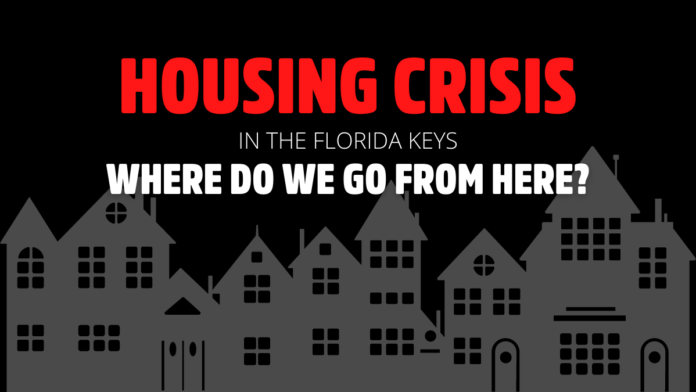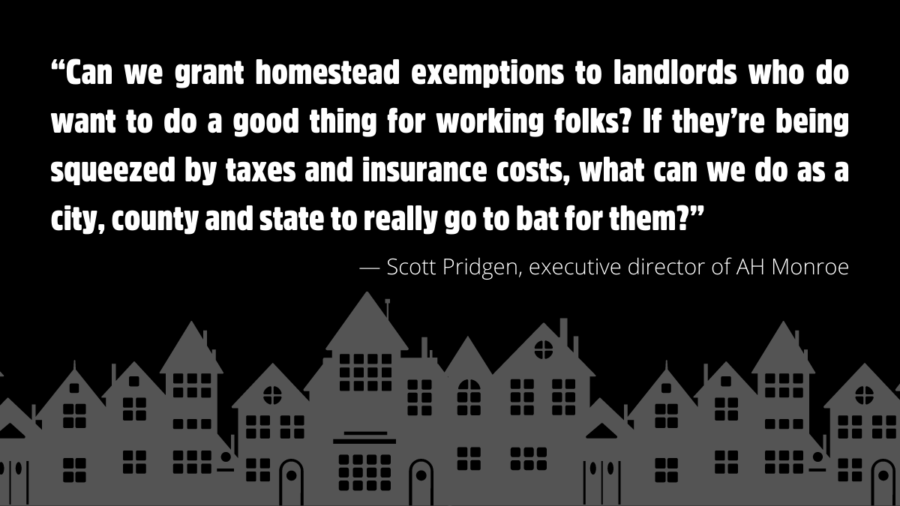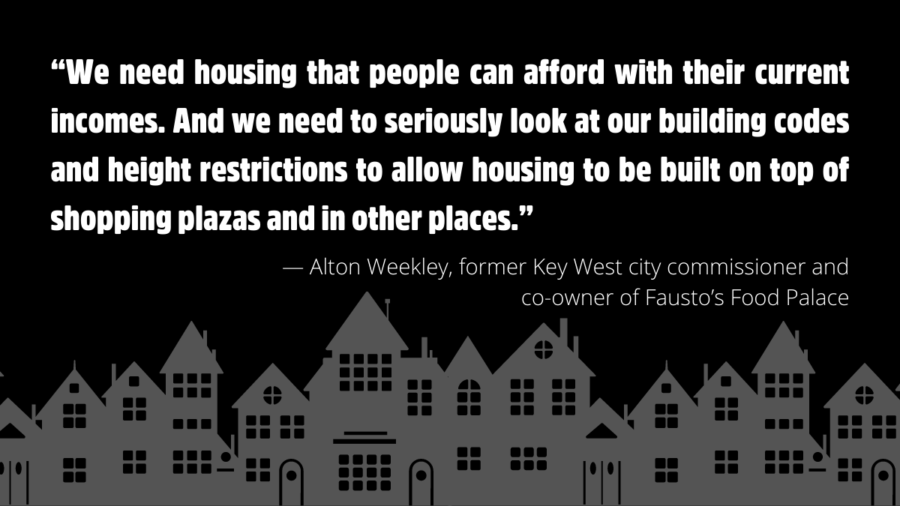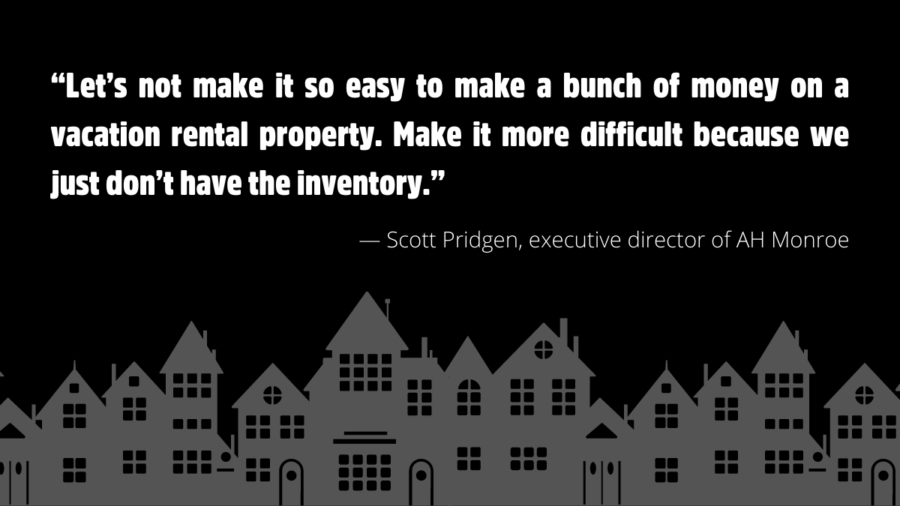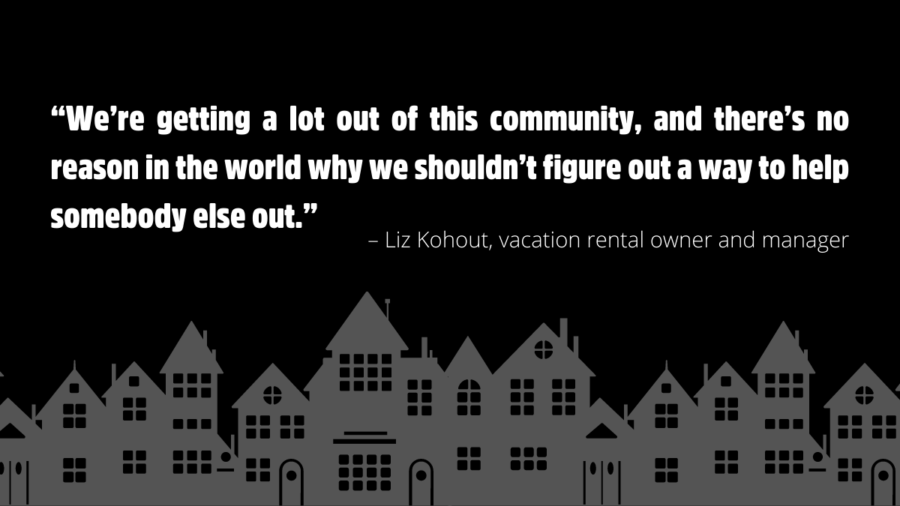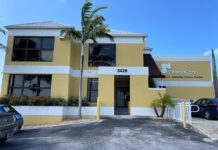Housing is the largest single challenge facing Florida Keys residents and has been for decades. With scarce buildable land, strict height restrictions, sky-high property values, second homes that sit empty most of the year and a proliferation of vacation rentals, many full-time workers no longer can afford to live or rent in the island chain, much less buy a home.
Over the past three weeks, Keys Weekly has tackled the Florida Keys housing crisis.
Part 1 defined the housing problem. Part 2 examined what caused it, and how we got here. This week, we take a look at some of the possible solutions. Ideas have been discussed for years during meetings and charrettes, aimed at solving a problem that’s only gotten worse over time. Some projects are underway throughout the island chain that could provide affordable housing options to the working folk. But is it enough? And in addition to new construction — in an island chain with limited land — what else could be done? Next week, the Keys Weekly will examine what other cities are doing to address the affordable housing shortage.
CONSTRUCTION PROJECTS
Upper Keys
Habitat for Humanity of the Upper Keys’ newest complex, Keys Heights, broke ground last year with four new affordable housing units on Plantation Key. Located at MM 89, bayside, the project includes three stand-alone elevated buildings. One is an upstairs/downstairs duplex. The units have three bedrooms with two bathrooms.
“We’ve got a teacher there. I got somebody who works at the Monroe County Tax Collector’s Office,” said Lindsay Fast, executive director of Habitat for Humanity of the Upper Keys.
It’s a model that’s working in the Upper Keys, with some 40 projects that have put working Keys families into a sustainable living situation. HFHUK works in partnership with people in need to build decent, affordable housing. The houses then are sold to those who qualify at no profit and with no interest charged.
Applicants who live or work in Monroe County are evaluated, and prospective homeowners are selected based on housing need, ability to pay and willingness to partner.
The partnership begins months in advance of moving in and includes putting in 250 to 350 hours of sweat equity. The ability to pay is based on a minimum credit score, income and other financial factors. Upon completion of construction, homeowners enter into a long-term, 0% interest mortgage with their payment based upon what they can afford.
With Keys Heights complete, Fast said Habitat now is working on bringing seven single-family homes and a duplex to Gardenia Street next to Plantation Key School. Fast wants to attract teachers given its proximity to the school. If all goes as planned, construction could start in about two months.
“They’re perfect for families,” she said. “I just reached out to the Monroe County School District to do a bit of a MOU (memorandum of understanding) I’d like to present to them during the building stages. It’s a perfect opportunity for teachers. They could literally walk.”
Among the bigger HFHUK projects is the Windley Key Condominiums. Of 16 units, eight are designated for ownership and eight for rentals. They’re two-bed, two-and-half-bath units with balconies and views of the oceanside.
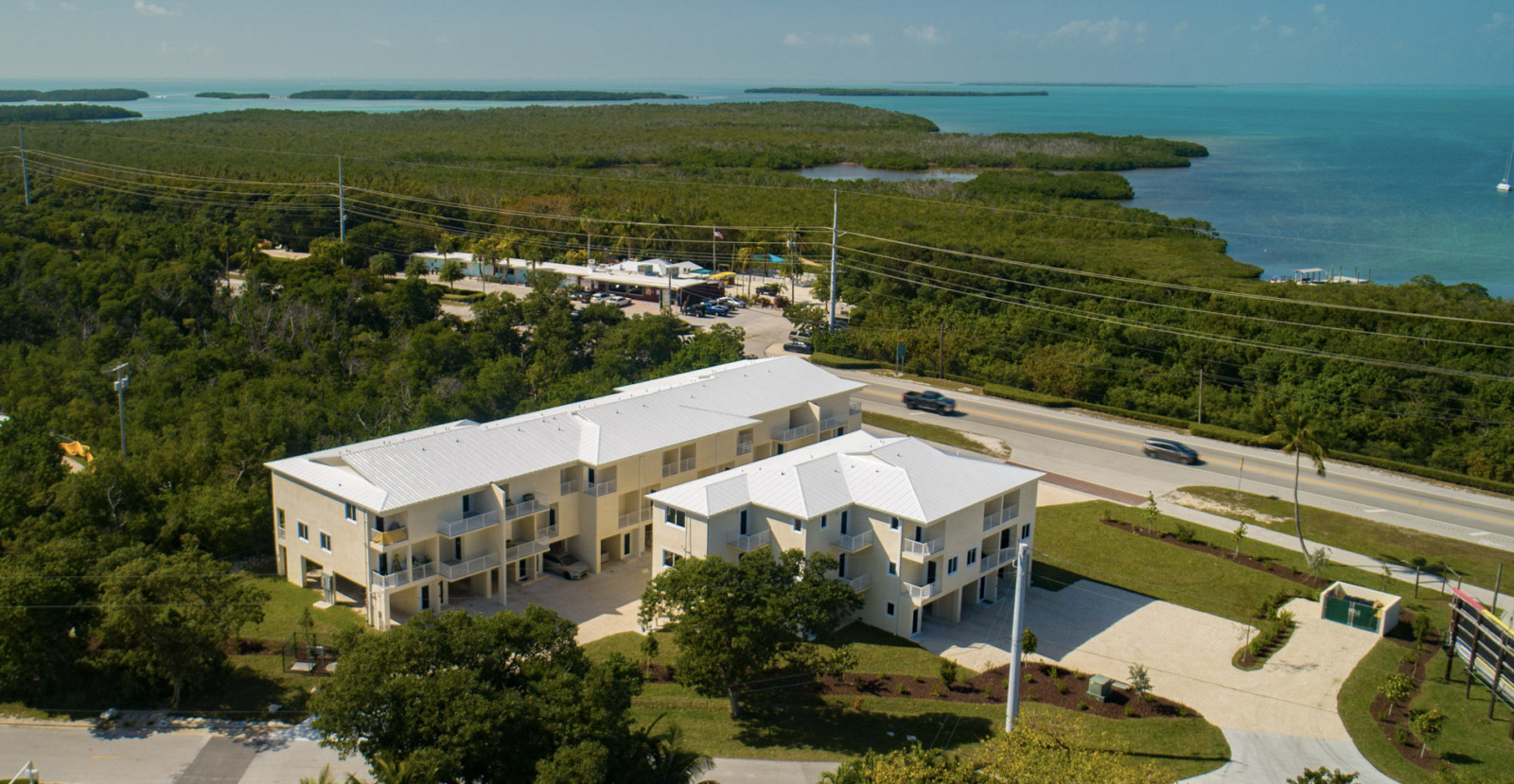
The complex is full. Fast said Keys workers, from a sheriff’s deputy to a fire rescuer, live there.
“Every year we qualify every rental, and we’re not just having them fill out applications. We’re getting pay stubs and W-2s,” Fast said.
Marathon
The City of Marathon has roughly 775 deed-restricted affordable housing units, with another 300 or so awarded and awaiting permitting and construction. “I think we’ve done everything we possibly can to essentially send a message to potential developers,” said Marathon City Manager George Garrett. “This is a place where they can find enough land to build affordable housing with enough units to make it financially feasible.”
Garrett said the ability of cities to incentivize or require truly affordable housing developments will be key moving forward. Take, for instance, Marathon’s “Trailerama,” a site stocked with about 120 mobile homes that is currently under contract. If the new owners decide to reimagine the property, hundreds of Marathon’s workforce could be without homes.
“When you look at something like Trailerama, our code has never anticipated that those projects would convert the way they are now,” said Garrett. “And therefore, we haven’t said, ‘Okay, if you convert, you’ve got to provide some percentage of workforce housing.’”
Should the property be redeveloped, the city’s priority would be to offer the incentive of additional density with affordable units as opposed to market rate alternatives.
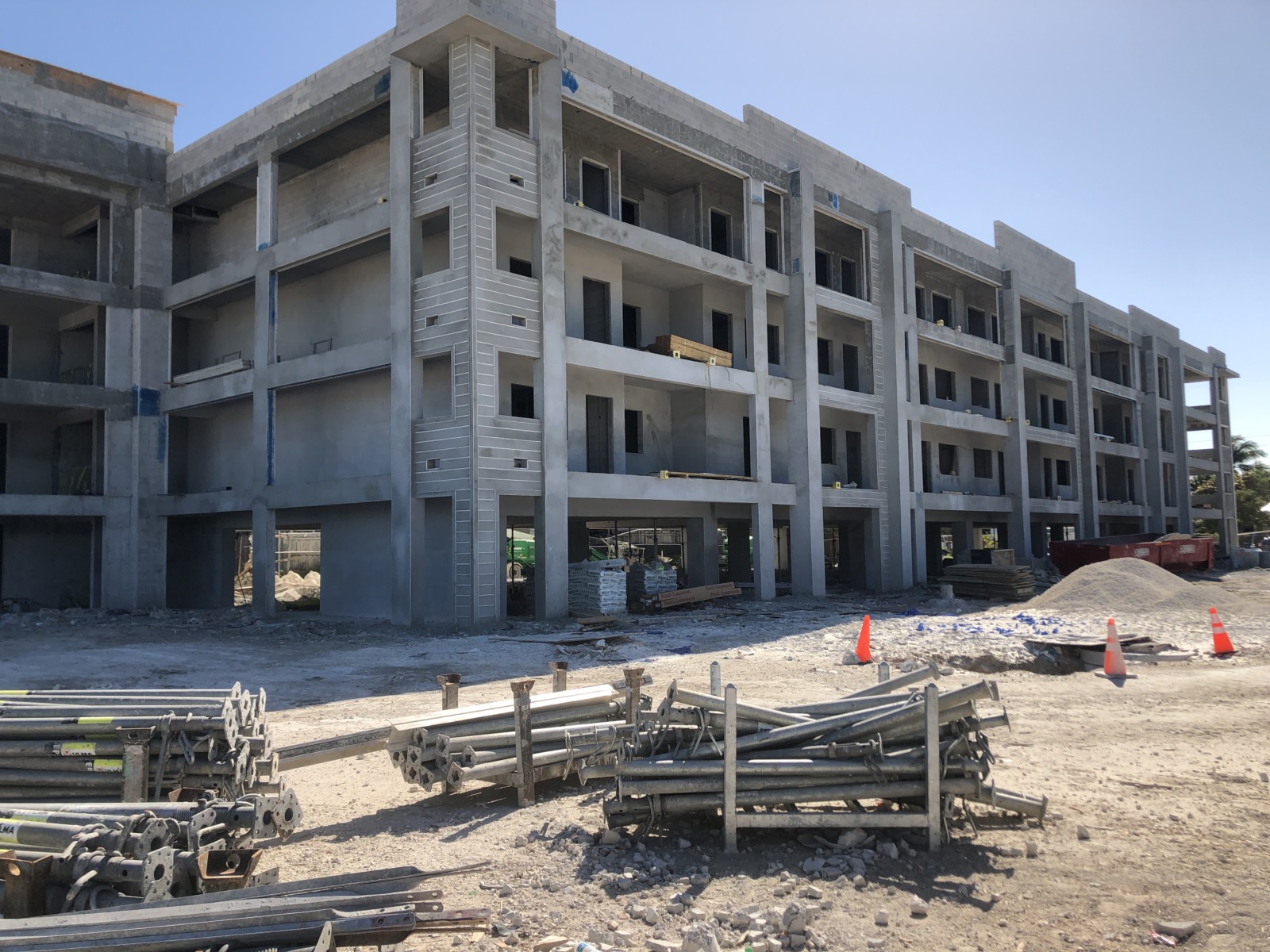
Key West
Three new affordable and workforce housing developments are underway in Key West and neighboring Stock Island.
Closest to completion is Wreckers Cay on Stock Island, a 280-unit apartment complex being constructed by Integra Investments and slated for partial completion this summer.\
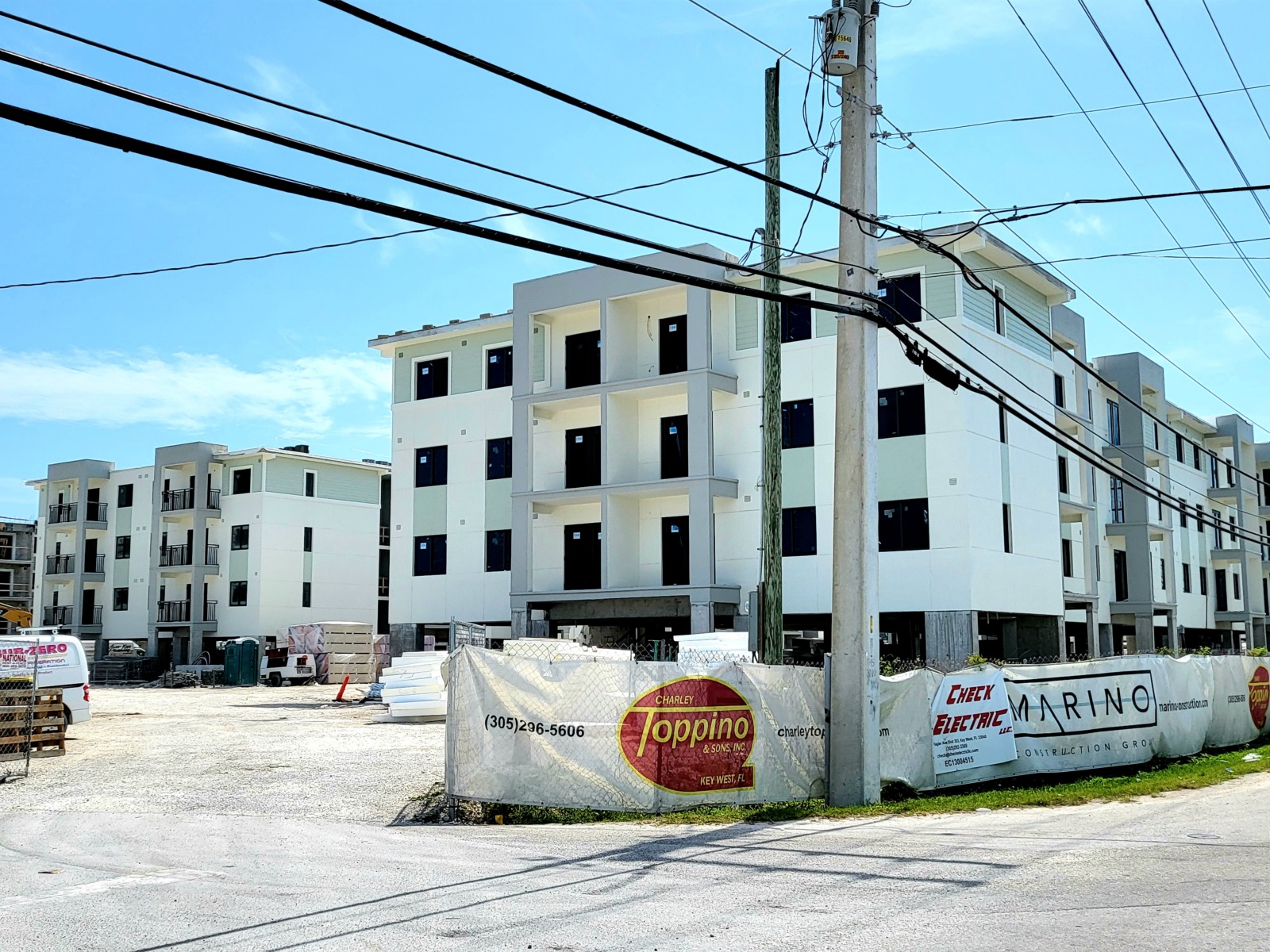
The new housing community will span nine waterfront acres on the site of a former trailer park and will feature 70 units for households earning up to 80% of the area median income (AMI), which is $56,960 for a two-person household, and $81,360 for a family of four. Wreckers Cay will have 98 units for households earning up to 100% of the AMI, which is $84,400 for a couple, and 112 units for households earning up to 120% of the AMI, which is $97,680 for a couple and $122,040 for a family of four.
Just down the road is the Key West Housing Authority- and the city of Key West-sponsored development known as Garden View Apartments on College Road, being built by Gulf Keystar local contractors. Like Wreckers Cay, the 103-unit apartment complex will be entirely affordable for varying income levels.
And finally, after 20 years on Key West’s to-do list, city commissioners this week approved a long-term ground lease that will enable about 168 units of affordable housing to be built at the city’s Truman Waterfront, with a combination of rental units and owned townhomes.
THE POLICIES
Last year, Islamorada Councilman Mark Gregg proposed an ordinance that would allow accessory dwelling units (ADU) in the village. The idea didn’t get the traction he hoped it would get from the community, but he says it’s a quick and cheap way to provide some housing that doesn’t involve any land clearing. And the idea isn’t new.
“For a homeowner on a limited income, that helps them to have more income to support staying in their house as prices rise and inflation gets worse and worse. It also allows somebody who needs affordable housing to have something nice,” he said.
Per the Florida Housing Coalition, ADUs were commonly used to mitigate the shortage of affordable housing, providing smaller rental dwelling units ancillary or secondary to the principal residence. In the 1950s and 1960s, with the rise of suburbs catering to nuclear families, ADUs fell out of favor.
But changing demographic trends showing continuing increases in smaller households, one-person households, elderly households and households with disabled members are creating a surging interest, the Florida Housing Coalition says.
“ADUs can provide a stable affordable housing option for those in vulnerable housing situations. Persons living in ADUs benefit financially as the lower rents allow them an affordable option for decent, safe housing,” states the coalition. “Additionally, those renting out the ADUs also benefit financially from the rental income stream which often provides the additional income owners, particularly those on a fixed income, need to make ends meet.”
Lorie Leal, Realtor with American Caribbean, said she believes there are opportunities for ADUs in the Keys.
“I think it would not only help the people that need to rent, but it would also help people afford homes because they would offset some of the ownership expense by having the rental unit on site,” she said. “It’s a sound solution. It would be on properties already developed.”
Gregg said he’s looking to bring back the ADU ordinance in the future. Among the communities with ADUs are Key West and several other Florida cities, as well as Portland, Oregon, and San Francisco.
“It will take a bit of time for the council, staff and community to absorb,” Gregg said. “As they learn more about it and learn it’s done all over the country, they’re popular with high-land costs and limited availability for land. This is not something I’m just pulling out of the hat and we’ve never heard of.”
Habitat for Humanity of the Middle Keys executive director Chris Todd Young says that while a plethora of factors have brought the Keys to their current predicament, a few crucial changes can go a long way. Though “affordable housing” is a convenient tagline, not all projects are created equal.
Affordable housing projects developed using tax credits charge different rents for more or less identical units based on a renter’s income. Meanwhile, while privately financed affordable housing projects, such as Marathon’s Tarpon Harbor and Seaward Landing, have income limits for their tenants, privately funded projects can sometimes still charge maximum rents based on incomes of 120% to 160% of the Area Median Income (AMI), even if a tenant’s income is far below this threshold.
Take, for instance, a single individual qualifying for Very Low Income housing with a salary of $35,600 or less, as dictated by Monroe County’s affordable housing numbers from 2021. The maximum monthly rate for a Very Low Income 1-bedroom unit is $1,018. But in a privately financed project charging rents based on 120% of AMI, monthly rent could shoot up to $2,442. Don’t worry about pulling out a calculator: this equates to a whopping 82% of the person’s monthly income. If the project is allowed to charge rents based on 140% to 160% of AMI, the situation worsens.
In Young’s mind, development agreements for affordable housing need to allow, and calculate rents based on, individuals making no more than 80% of the AMI, a number she calls a true “workforce salary.”
For many middle-income Keys residents, the problem isn’t the ability to pay a mortgage once they have a house. For the group Young calls the “invisible class” – ones whose salaries aren’t low enough to qualify for significant assistance programs, but still find most of their income sapped away by sky-high rents and basic living expenses without a significant ability to save – the issue is finding money for a down payment.
To break through this barrier, she is one of many who have asked Marathon to increase its first-time home buyer’s grant from $10,000 to $20,000 or even $30,000. The Marathon City Council is set to revisit the issue at its regular meeting on Tuesday, April 12.
EMPLOYERS FEEL THE CRUNCH, TOO
Keys employers haven’t turned a blind eye to the housing crisis in recent years. Several have realized that their only chance of retaining a long-term workforce is to invest in dedicated employee or other affordable housing.
Liz Kohout and her business partner “Captain Bob” Stephens have taken things one step further. As vacation rental owners and managers, they rewarded Yandry Gonzalez, an employee they consider “like a son,” with a chance at home ownership he may have never found otherwise.
“Once he started working more for us and making more money, he was told that he no longer qualified for the housing where he and his family were staying,” said Kohout. “To me, that seems pretty un-American to punish someone for getting ahead.”
Determined to prevent their most industrious worker from leaving the Keys, Kohout and Stephens entered into an agreement with Gonzalez to help him put the down payment on his own house. The plan is for Yandry eventually to buy the pair out, leaving his family of four with a home all their own.
“We believed so strongly in buying a house for Yandry first that we don’t even have a house of our own,” said Kohout.
In Key West, Alton Weekley, a former city commissioner whose family owns Fausto’s Food Palace, ended up buying the mobile home that a valuable employee was renting.
“Then I ended up selling it to her, so I carry the loan. She was too valuable to lose to our housing shortage,” he said.
Other residents and Keys leaders have long talked about providing financial incentives to help encourage landlords who rent their properties long term to year-round workers.
“We need to make the fees and taxes so high on AirBnBs and vacation rentals so it’s a less attractive option,” said Scott Pridgen, executive director of AH Monroe, a nonprofit dedicated to affordable housing and health care.
Former Key West city commissioner Margaret Romero has also long supported financial incentives for long-term landlords, but got no support from fellow commissioners during her tenure.
LESSONS LEARNED
Hindsight is always 20/20, and some past decisions have Key West officials and residents shaking their heads at what might have been.
Weekley recalled that he first sat on a Key West Chamber of Commerce affordable housing committee as far back as the “late ’70s or early ’80s.”
“Around that time it became very obvious that the displacement of people would continue happening,” said Weekley, whose brother, Jimmy, is a former Key West mayor and a current city commissioner. “But what we’re facing today didn’t happen overnight.”
When he was a city commissioner from 1977 to 1981, the Navy was getting rid of its Truman Annex property and putting it on the market.
“As a city commission, we were going to buy the property and lease it to a developer for 99 years to build housing there. The developer was going to front the city $16 million to buy the land, because the city didn’t have the money back then. A big part of the housing was going to be affordable. But every city commission has the attitude that the commissioners before them did everything wrong. The new commission decided the Truman Annex purchase wasn’t in the city’s best interest and pulled out. As we all know, developer Pritam Singh, whom I respect, bought the property and developed it into today’s Truman Annex,” which includes luxury homes that are predominantly monthly and transient rentals.
“I’ve also always thought that Harris School should have become housing,” he said. “If I had the $4 or $6 million, I would’ve bought it and turned it into housing.”
During a recent Islamorada council meeting, Gregg discussed raising the salaries of council members from the current $1,000 they get a month. The whole goal, he said, is to bring younger members of the community who can’t get away from their day job to attend meetings. In his remarks, he said a raise should have happened long ago. And it could have brought a single mom or working family’s voice to the table.
“I think if we had done this years ago, if someone on the council was a wage earner, a single mom or dad, we might not be in the pickle we are in now with affordable housing because there would have been a voice at the table to push that forward,” he said.
















